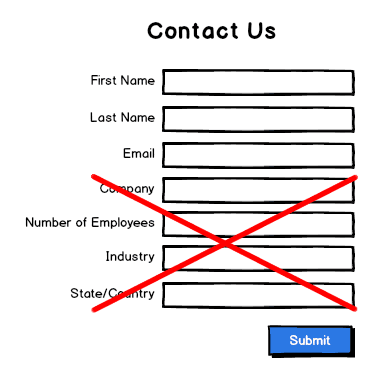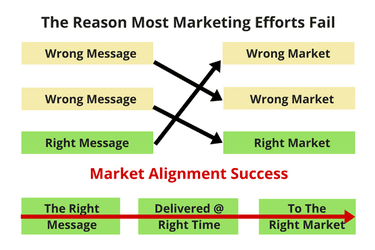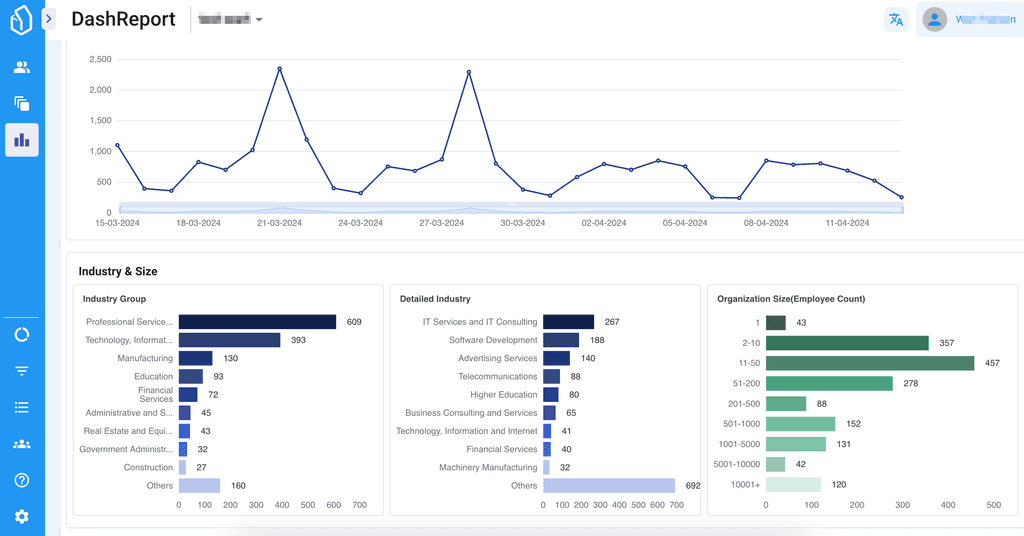
Lead Generation|Marketing
B2B Lead Strategy and Marketing Alignment
B2B Lead Strategy and Marketing Alignment
2021-05-30

Lead Generation|Marketing
B2B Lead Strategy and Marketing Alignment
2021-05-30

Lead Generation|Marketing
B2B Lead Strategy and Marketing Alignment
2021-05-30
Table of Contents
Auto Generated TOC
Auto Generated TOC
Auto Generated TOC
Auto Generated TOC
Business-to-business (B2B) sales involve companies selling products and services to other businesses. B2B companies either sell items to another company so they can make their own products or meet a specific need.
The Purpose of a Good B2B Lead Strategy
In B2B sales, you’re likely to deal with several decision-makers within one company. In fact, salespeople engaged in B2B sales will need to work with an average of seven decision-makers. These people include CEOs, sales representatives, board members, and those in the financial and legal departments.Selling to a group of people is different than pitching to an individual as in business-to-consumer (B2C) sales. The need to successfully make a pitch to individuals with varying perspectives differentiates B2B lead strategy from that required for B2C sales.

Elements of an Effective B2B Lead Strategy
Relationship building is essential to both B2B and B2C lead strategies but takes on increased importance in the B2B arena. Here are some elements of a successful business-to-business lead sales and marketing strategy:
Know Your Prospects
Researching those you’re selling your product or service to will improve your chance of a successful transaction. Keep in mind, not every business prospect is a good fit. If you know this beforehand, you’ll avoid wasting time and energy that could be spent on quality leads.
Focus on Building Relationships
Typically, the B2B sales and relationship-building processes take more time in comparison to B2C. In B2B, businesses lose 45-50% of their clients over five years, which is significant and must be addressed.To avoid losing B2B prospects, building and maintaining long-term relationships through a strong lead nurturing strategy is encouraged. B2B sales bring in more revenue than B2C sales as you’re dealing with companies, not individual consumers. When a B2B client is lost, thousands, not hundreds of dollars can disappear.
Build an Effective Website
Most B2B leads will do thorough research before making a purchasing decision. They will examine your website and social media profiles. Make sure these look professional, and that your website is easy to navigate and clearly states your company mission, background, and includes testimonials from satisfied clients.
Establish a Social Media Presence
Having a powerful social media presence is beneficial in many ways. It can offer your sales and marketing departments the following advantages:
Insight into your competitors and prospects
An avenue to establish credibility
A means for building trust with leads and buyers
Opportunities to reach out to prospects and buyers
Allows social selling
Helps share content
Use Email Marketing
According to Marketing Sherpa, 64% of respondents believe email marketing delivers the best return on investment. Email marketing is effective in cultivating relationships with business prospects and in nurturing them through the sales funnel.

The Importance of Sales and Marketing Alignment
As mentioned previously, relationships are a crucial element in B2B sales. Everything in your B2B strategy should revolve around building long-term relationships with business prospects. A strong business-to-business leads strategy will involve both the sales and marketing teams.Your organization will appear more credible and trustworthy when the marketing and sales teams work together. Companies with a B2B strategy that features sales and marketing alignment are more successful in nurturing prospects into buyers.
Throughout the marketing and sales processes, both departments work together to provide a cohesive, smooth experience for prospects. Marketing produces valuable content at each stage of the funnel while sales provides personal and prompt lead follow-up. Both sales and marketing must do all they can to serve, nurture, and build relationships with each lead.
Market Alignment Goals
Your marketing message plays a big role in the success of your company’s B2B sales. Market alignment is defined as “the process of creating a marketing message that is appropriately aligned, or in sync, with the target audience the message is intended to persuade.” The goal of your market alignment is to deliver the right message at the right time to the right prospects.
This is achieved when you focus on the buyer’s needs rather than on emphasizing how good your company, products, and services are. Knowing your prospects, their pain points, and how your services and products can help, builds trust and a rapport. The early relationship-building formed by market alignment messaging improves the chances of a sale.
To fully understand which prospects your marketing department should be targeting, regular collaboration with the sales team is required. When marketing and sales are properly aligned, customer-centric messaging is incorporated into each sales funnel stage. Marketing can introduce market alignment messaging into content and sales can include it in lead follow-up and nurturing initiatives.

Sales and Marketing Misalignment Issues
When sales and marketing aren’t on the same page problems ensue. Beyond the miscommunication and contradictory messaging issues that are bound to occur, misalignment can negatively affect the buyer’s journey. This lack of cohesiveness makes it more difficult to convert B2B leads into paying customers.
Issue #1: Poor Marketing Qualified Leads
A common marketing and sales misalignment issue is the failure to produce marketing qualified leads (MQLs) to sales. As a result, the sales team is stuck with poor prospects that do not respond to lead nurturing efforts. In turn, these leads fail to convert into paying customers.
Issue #2: Lack of Lead Follow-Up and Nurturing
Whether prospects are qualified or not, marketers can get frustrated at sales for not following up and nurturing the leads they are given. Once the marketing department hands off prospects to sales, its nurturing endeavors may end.
Issue #3: Poor Marketing to Sales Handoff
When the sales and marketing teams use different lead qualification requirements, the prospect handoff can cause problems. When prospective buyers are handed off from marketing to sales, mixed messaging can occur. Leads are quick to notice the inconsistency and may be hesitant to move forward along the sales funnel.
Issue #4: Lack of ROI Attributed to Marketing
In some cases, marketers don’t know how their lead generation impacts the company’s return on investment (ROI). This can alienate the marketing team and lower the incentive and motivation for your marketers to aggressively seek the new leads your company needs.
Strategies for Meeting Your Marketing Goals
Common B2B marketing goals include producing qualified leads for your sales team, creating valuable, targeted content, and building relationships with buyers. Successfully completing these tasks plays an essential role in bringing awareness to your brand, products, and services. These goals are more attainable when they are S.M.A.R.T goals (specific, measurable, attainable, relevant, timely).Here are some B2B marketing goal strategies to try:
Establish MQLs Criteria: Work with your sales team to create uniform marketing qualified leads criteria. Only prospects that meet all of these established conditions should be referred to sales for nurturing.
Track Marketing ROI Contribution: Inform your marketers of how their lead generation efforts have directly contributed to the company’s ROI.
Involve Marketers in the Sales Process: Create opportunities for your marketers to sit in on sales calls and learn the overall selling process.
Utilize Marketing Automation Tools: Synchronize your company’s email and scheduling software between sales and marketing. Using the same program, a singular marketing message can be carried through in follow-ups by the sales team.
Create Unique Content for Each Step of the Buyer’s Journey: Marketers can create targeted content using buyer data, marketing goals, buyer personas, and lead generation strategies. The diversity of content is geared toward prospects in each stage of the sales funnel.

Source
Marketing Content
The foundation of your content marketing strategy should be centered around your buyers’ pain points and your company’s unique selling proposition. B2B leads will be more trusting of a company that demonstrates how it is focused on them and the ways it can help them to succeed. Referencing your company’s unique value proposition will make you stand out from your competitors.
Successful marketers build long-term relationships with B2B prospects, generate qualified leads, and help convert those leads into paying buyers. Throughout the buyer’s journey, there are opportunities to meet these marketing goals through content. Your content needs to build prospect trust, establish and reinforce brand authority, and resolve lead queries and concerns.
Your marketing content should provide valuable information to the right prospects, at the right time. The alignment of your marketing message should be adopted by your sales team when they interact with leads. Knowledge of the sales process will help form marketing content for each stage of the sales funnel.
Here are things to keep in mind when building relationships with B2B leads through content marketing:
Create a content library to guide prospects through the buyer journey
Share the content library with your sales department
Use gated content
Your content is for informing and educating, not selling
Keep the buyer at the center of your messaging
Use a variety of content pieces
To attract buyers, there must be sales and marketing alignment. Your market alignment messaging needs to be buyer-centered. There are many opportunities throughout the sales funnel to effectively use content marketing to reach prospects along the buyer’s journey.
Without a cohesive B2B lead strategy and sales and marketing alignment, you risk losing prospects. When your messaging is off, you may get unqualified leads.
LeadBoxer’s sales lead scoring platform enables you to correctly identify the best business-to-business buyers.
Business-to-business (B2B) sales involve companies selling products and services to other businesses. B2B companies either sell items to another company so they can make their own products or meet a specific need.
The Purpose of a Good B2B Lead Strategy
In B2B sales, you’re likely to deal with several decision-makers within one company. In fact, salespeople engaged in B2B sales will need to work with an average of seven decision-makers. These people include CEOs, sales representatives, board members, and those in the financial and legal departments.Selling to a group of people is different than pitching to an individual as in business-to-consumer (B2C) sales. The need to successfully make a pitch to individuals with varying perspectives differentiates B2B lead strategy from that required for B2C sales.

Elements of an Effective B2B Lead Strategy
Relationship building is essential to both B2B and B2C lead strategies but takes on increased importance in the B2B arena. Here are some elements of a successful business-to-business lead sales and marketing strategy:
Know Your Prospects
Researching those you’re selling your product or service to will improve your chance of a successful transaction. Keep in mind, not every business prospect is a good fit. If you know this beforehand, you’ll avoid wasting time and energy that could be spent on quality leads.
Focus on Building Relationships
Typically, the B2B sales and relationship-building processes take more time in comparison to B2C. In B2B, businesses lose 45-50% of their clients over five years, which is significant and must be addressed.To avoid losing B2B prospects, building and maintaining long-term relationships through a strong lead nurturing strategy is encouraged. B2B sales bring in more revenue than B2C sales as you’re dealing with companies, not individual consumers. When a B2B client is lost, thousands, not hundreds of dollars can disappear.
Build an Effective Website
Most B2B leads will do thorough research before making a purchasing decision. They will examine your website and social media profiles. Make sure these look professional, and that your website is easy to navigate and clearly states your company mission, background, and includes testimonials from satisfied clients.
Establish a Social Media Presence
Having a powerful social media presence is beneficial in many ways. It can offer your sales and marketing departments the following advantages:
Insight into your competitors and prospects
An avenue to establish credibility
A means for building trust with leads and buyers
Opportunities to reach out to prospects and buyers
Allows social selling
Helps share content
Use Email Marketing
According to Marketing Sherpa, 64% of respondents believe email marketing delivers the best return on investment. Email marketing is effective in cultivating relationships with business prospects and in nurturing them through the sales funnel.

The Importance of Sales and Marketing Alignment
As mentioned previously, relationships are a crucial element in B2B sales. Everything in your B2B strategy should revolve around building long-term relationships with business prospects. A strong business-to-business leads strategy will involve both the sales and marketing teams.Your organization will appear more credible and trustworthy when the marketing and sales teams work together. Companies with a B2B strategy that features sales and marketing alignment are more successful in nurturing prospects into buyers.
Throughout the marketing and sales processes, both departments work together to provide a cohesive, smooth experience for prospects. Marketing produces valuable content at each stage of the funnel while sales provides personal and prompt lead follow-up. Both sales and marketing must do all they can to serve, nurture, and build relationships with each lead.
Market Alignment Goals
Your marketing message plays a big role in the success of your company’s B2B sales. Market alignment is defined as “the process of creating a marketing message that is appropriately aligned, or in sync, with the target audience the message is intended to persuade.” The goal of your market alignment is to deliver the right message at the right time to the right prospects.
This is achieved when you focus on the buyer’s needs rather than on emphasizing how good your company, products, and services are. Knowing your prospects, their pain points, and how your services and products can help, builds trust and a rapport. The early relationship-building formed by market alignment messaging improves the chances of a sale.
To fully understand which prospects your marketing department should be targeting, regular collaboration with the sales team is required. When marketing and sales are properly aligned, customer-centric messaging is incorporated into each sales funnel stage. Marketing can introduce market alignment messaging into content and sales can include it in lead follow-up and nurturing initiatives.

Sales and Marketing Misalignment Issues
When sales and marketing aren’t on the same page problems ensue. Beyond the miscommunication and contradictory messaging issues that are bound to occur, misalignment can negatively affect the buyer’s journey. This lack of cohesiveness makes it more difficult to convert B2B leads into paying customers.
Issue #1: Poor Marketing Qualified Leads
A common marketing and sales misalignment issue is the failure to produce marketing qualified leads (MQLs) to sales. As a result, the sales team is stuck with poor prospects that do not respond to lead nurturing efforts. In turn, these leads fail to convert into paying customers.
Issue #2: Lack of Lead Follow-Up and Nurturing
Whether prospects are qualified or not, marketers can get frustrated at sales for not following up and nurturing the leads they are given. Once the marketing department hands off prospects to sales, its nurturing endeavors may end.
Issue #3: Poor Marketing to Sales Handoff
When the sales and marketing teams use different lead qualification requirements, the prospect handoff can cause problems. When prospective buyers are handed off from marketing to sales, mixed messaging can occur. Leads are quick to notice the inconsistency and may be hesitant to move forward along the sales funnel.
Issue #4: Lack of ROI Attributed to Marketing
In some cases, marketers don’t know how their lead generation impacts the company’s return on investment (ROI). This can alienate the marketing team and lower the incentive and motivation for your marketers to aggressively seek the new leads your company needs.
Strategies for Meeting Your Marketing Goals
Common B2B marketing goals include producing qualified leads for your sales team, creating valuable, targeted content, and building relationships with buyers. Successfully completing these tasks plays an essential role in bringing awareness to your brand, products, and services. These goals are more attainable when they are S.M.A.R.T goals (specific, measurable, attainable, relevant, timely).Here are some B2B marketing goal strategies to try:
Establish MQLs Criteria: Work with your sales team to create uniform marketing qualified leads criteria. Only prospects that meet all of these established conditions should be referred to sales for nurturing.
Track Marketing ROI Contribution: Inform your marketers of how their lead generation efforts have directly contributed to the company’s ROI.
Involve Marketers in the Sales Process: Create opportunities for your marketers to sit in on sales calls and learn the overall selling process.
Utilize Marketing Automation Tools: Synchronize your company’s email and scheduling software between sales and marketing. Using the same program, a singular marketing message can be carried through in follow-ups by the sales team.
Create Unique Content for Each Step of the Buyer’s Journey: Marketers can create targeted content using buyer data, marketing goals, buyer personas, and lead generation strategies. The diversity of content is geared toward prospects in each stage of the sales funnel.

Source
Marketing Content
The foundation of your content marketing strategy should be centered around your buyers’ pain points and your company’s unique selling proposition. B2B leads will be more trusting of a company that demonstrates how it is focused on them and the ways it can help them to succeed. Referencing your company’s unique value proposition will make you stand out from your competitors.
Successful marketers build long-term relationships with B2B prospects, generate qualified leads, and help convert those leads into paying buyers. Throughout the buyer’s journey, there are opportunities to meet these marketing goals through content. Your content needs to build prospect trust, establish and reinforce brand authority, and resolve lead queries and concerns.
Your marketing content should provide valuable information to the right prospects, at the right time. The alignment of your marketing message should be adopted by your sales team when they interact with leads. Knowledge of the sales process will help form marketing content for each stage of the sales funnel.
Here are things to keep in mind when building relationships with B2B leads through content marketing:
Create a content library to guide prospects through the buyer journey
Share the content library with your sales department
Use gated content
Your content is for informing and educating, not selling
Keep the buyer at the center of your messaging
Use a variety of content pieces
To attract buyers, there must be sales and marketing alignment. Your market alignment messaging needs to be buyer-centered. There are many opportunities throughout the sales funnel to effectively use content marketing to reach prospects along the buyer’s journey.
Without a cohesive B2B lead strategy and sales and marketing alignment, you risk losing prospects. When your messaging is off, you may get unqualified leads.
LeadBoxer’s sales lead scoring platform enables you to correctly identify the best business-to-business buyers.
Business-to-business (B2B) sales involve companies selling products and services to other businesses. B2B companies either sell items to another company so they can make their own products or meet a specific need.
The Purpose of a Good B2B Lead Strategy
In B2B sales, you’re likely to deal with several decision-makers within one company. In fact, salespeople engaged in B2B sales will need to work with an average of seven decision-makers. These people include CEOs, sales representatives, board members, and those in the financial and legal departments.Selling to a group of people is different than pitching to an individual as in business-to-consumer (B2C) sales. The need to successfully make a pitch to individuals with varying perspectives differentiates B2B lead strategy from that required for B2C sales.

Elements of an Effective B2B Lead Strategy
Relationship building is essential to both B2B and B2C lead strategies but takes on increased importance in the B2B arena. Here are some elements of a successful business-to-business lead sales and marketing strategy:
Know Your Prospects
Researching those you’re selling your product or service to will improve your chance of a successful transaction. Keep in mind, not every business prospect is a good fit. If you know this beforehand, you’ll avoid wasting time and energy that could be spent on quality leads.
Focus on Building Relationships
Typically, the B2B sales and relationship-building processes take more time in comparison to B2C. In B2B, businesses lose 45-50% of their clients over five years, which is significant and must be addressed.To avoid losing B2B prospects, building and maintaining long-term relationships through a strong lead nurturing strategy is encouraged. B2B sales bring in more revenue than B2C sales as you’re dealing with companies, not individual consumers. When a B2B client is lost, thousands, not hundreds of dollars can disappear.
Build an Effective Website
Most B2B leads will do thorough research before making a purchasing decision. They will examine your website and social media profiles. Make sure these look professional, and that your website is easy to navigate and clearly states your company mission, background, and includes testimonials from satisfied clients.
Establish a Social Media Presence
Having a powerful social media presence is beneficial in many ways. It can offer your sales and marketing departments the following advantages:
Insight into your competitors and prospects
An avenue to establish credibility
A means for building trust with leads and buyers
Opportunities to reach out to prospects and buyers
Allows social selling
Helps share content
Use Email Marketing
According to Marketing Sherpa, 64% of respondents believe email marketing delivers the best return on investment. Email marketing is effective in cultivating relationships with business prospects and in nurturing them through the sales funnel.

The Importance of Sales and Marketing Alignment
As mentioned previously, relationships are a crucial element in B2B sales. Everything in your B2B strategy should revolve around building long-term relationships with business prospects. A strong business-to-business leads strategy will involve both the sales and marketing teams.Your organization will appear more credible and trustworthy when the marketing and sales teams work together. Companies with a B2B strategy that features sales and marketing alignment are more successful in nurturing prospects into buyers.
Throughout the marketing and sales processes, both departments work together to provide a cohesive, smooth experience for prospects. Marketing produces valuable content at each stage of the funnel while sales provides personal and prompt lead follow-up. Both sales and marketing must do all they can to serve, nurture, and build relationships with each lead.
Market Alignment Goals
Your marketing message plays a big role in the success of your company’s B2B sales. Market alignment is defined as “the process of creating a marketing message that is appropriately aligned, or in sync, with the target audience the message is intended to persuade.” The goal of your market alignment is to deliver the right message at the right time to the right prospects.
This is achieved when you focus on the buyer’s needs rather than on emphasizing how good your company, products, and services are. Knowing your prospects, their pain points, and how your services and products can help, builds trust and a rapport. The early relationship-building formed by market alignment messaging improves the chances of a sale.
To fully understand which prospects your marketing department should be targeting, regular collaboration with the sales team is required. When marketing and sales are properly aligned, customer-centric messaging is incorporated into each sales funnel stage. Marketing can introduce market alignment messaging into content and sales can include it in lead follow-up and nurturing initiatives.

Sales and Marketing Misalignment Issues
When sales and marketing aren’t on the same page problems ensue. Beyond the miscommunication and contradictory messaging issues that are bound to occur, misalignment can negatively affect the buyer’s journey. This lack of cohesiveness makes it more difficult to convert B2B leads into paying customers.
Issue #1: Poor Marketing Qualified Leads
A common marketing and sales misalignment issue is the failure to produce marketing qualified leads (MQLs) to sales. As a result, the sales team is stuck with poor prospects that do not respond to lead nurturing efforts. In turn, these leads fail to convert into paying customers.
Issue #2: Lack of Lead Follow-Up and Nurturing
Whether prospects are qualified or not, marketers can get frustrated at sales for not following up and nurturing the leads they are given. Once the marketing department hands off prospects to sales, its nurturing endeavors may end.
Issue #3: Poor Marketing to Sales Handoff
When the sales and marketing teams use different lead qualification requirements, the prospect handoff can cause problems. When prospective buyers are handed off from marketing to sales, mixed messaging can occur. Leads are quick to notice the inconsistency and may be hesitant to move forward along the sales funnel.
Issue #4: Lack of ROI Attributed to Marketing
In some cases, marketers don’t know how their lead generation impacts the company’s return on investment (ROI). This can alienate the marketing team and lower the incentive and motivation for your marketers to aggressively seek the new leads your company needs.
Strategies for Meeting Your Marketing Goals
Common B2B marketing goals include producing qualified leads for your sales team, creating valuable, targeted content, and building relationships with buyers. Successfully completing these tasks plays an essential role in bringing awareness to your brand, products, and services. These goals are more attainable when they are S.M.A.R.T goals (specific, measurable, attainable, relevant, timely).Here are some B2B marketing goal strategies to try:
Establish MQLs Criteria: Work with your sales team to create uniform marketing qualified leads criteria. Only prospects that meet all of these established conditions should be referred to sales for nurturing.
Track Marketing ROI Contribution: Inform your marketers of how their lead generation efforts have directly contributed to the company’s ROI.
Involve Marketers in the Sales Process: Create opportunities for your marketers to sit in on sales calls and learn the overall selling process.
Utilize Marketing Automation Tools: Synchronize your company’s email and scheduling software between sales and marketing. Using the same program, a singular marketing message can be carried through in follow-ups by the sales team.
Create Unique Content for Each Step of the Buyer’s Journey: Marketers can create targeted content using buyer data, marketing goals, buyer personas, and lead generation strategies. The diversity of content is geared toward prospects in each stage of the sales funnel.

Source
Marketing Content
The foundation of your content marketing strategy should be centered around your buyers’ pain points and your company’s unique selling proposition. B2B leads will be more trusting of a company that demonstrates how it is focused on them and the ways it can help them to succeed. Referencing your company’s unique value proposition will make you stand out from your competitors.
Successful marketers build long-term relationships with B2B prospects, generate qualified leads, and help convert those leads into paying buyers. Throughout the buyer’s journey, there are opportunities to meet these marketing goals through content. Your content needs to build prospect trust, establish and reinforce brand authority, and resolve lead queries and concerns.
Your marketing content should provide valuable information to the right prospects, at the right time. The alignment of your marketing message should be adopted by your sales team when they interact with leads. Knowledge of the sales process will help form marketing content for each stage of the sales funnel.
Here are things to keep in mind when building relationships with B2B leads through content marketing:
Create a content library to guide prospects through the buyer journey
Share the content library with your sales department
Use gated content
Your content is for informing and educating, not selling
Keep the buyer at the center of your messaging
Use a variety of content pieces
To attract buyers, there must be sales and marketing alignment. Your market alignment messaging needs to be buyer-centered. There are many opportunities throughout the sales funnel to effectively use content marketing to reach prospects along the buyer’s journey.
Without a cohesive B2B lead strategy and sales and marketing alignment, you risk losing prospects. When your messaging is off, you may get unqualified leads.
LeadBoxer’s sales lead scoring platform enables you to correctly identify the best business-to-business buyers.
Business-to-business (B2B) sales involve companies selling products and services to other businesses. B2B companies either sell items to another company so they can make their own products or meet a specific need.
The Purpose of a Good B2B Lead Strategy
In B2B sales, you’re likely to deal with several decision-makers within one company. In fact, salespeople engaged in B2B sales will need to work with an average of seven decision-makers. These people include CEOs, sales representatives, board members, and those in the financial and legal departments.Selling to a group of people is different than pitching to an individual as in business-to-consumer (B2C) sales. The need to successfully make a pitch to individuals with varying perspectives differentiates B2B lead strategy from that required for B2C sales.

Elements of an Effective B2B Lead Strategy
Relationship building is essential to both B2B and B2C lead strategies but takes on increased importance in the B2B arena. Here are some elements of a successful business-to-business lead sales and marketing strategy:
Know Your Prospects
Researching those you’re selling your product or service to will improve your chance of a successful transaction. Keep in mind, not every business prospect is a good fit. If you know this beforehand, you’ll avoid wasting time and energy that could be spent on quality leads.
Focus on Building Relationships
Typically, the B2B sales and relationship-building processes take more time in comparison to B2C. In B2B, businesses lose 45-50% of their clients over five years, which is significant and must be addressed.To avoid losing B2B prospects, building and maintaining long-term relationships through a strong lead nurturing strategy is encouraged. B2B sales bring in more revenue than B2C sales as you’re dealing with companies, not individual consumers. When a B2B client is lost, thousands, not hundreds of dollars can disappear.
Build an Effective Website
Most B2B leads will do thorough research before making a purchasing decision. They will examine your website and social media profiles. Make sure these look professional, and that your website is easy to navigate and clearly states your company mission, background, and includes testimonials from satisfied clients.
Establish a Social Media Presence
Having a powerful social media presence is beneficial in many ways. It can offer your sales and marketing departments the following advantages:
Insight into your competitors and prospects
An avenue to establish credibility
A means for building trust with leads and buyers
Opportunities to reach out to prospects and buyers
Allows social selling
Helps share content
Use Email Marketing
According to Marketing Sherpa, 64% of respondents believe email marketing delivers the best return on investment. Email marketing is effective in cultivating relationships with business prospects and in nurturing them through the sales funnel.

The Importance of Sales and Marketing Alignment
As mentioned previously, relationships are a crucial element in B2B sales. Everything in your B2B strategy should revolve around building long-term relationships with business prospects. A strong business-to-business leads strategy will involve both the sales and marketing teams.Your organization will appear more credible and trustworthy when the marketing and sales teams work together. Companies with a B2B strategy that features sales and marketing alignment are more successful in nurturing prospects into buyers.
Throughout the marketing and sales processes, both departments work together to provide a cohesive, smooth experience for prospects. Marketing produces valuable content at each stage of the funnel while sales provides personal and prompt lead follow-up. Both sales and marketing must do all they can to serve, nurture, and build relationships with each lead.
Market Alignment Goals
Your marketing message plays a big role in the success of your company’s B2B sales. Market alignment is defined as “the process of creating a marketing message that is appropriately aligned, or in sync, with the target audience the message is intended to persuade.” The goal of your market alignment is to deliver the right message at the right time to the right prospects.
This is achieved when you focus on the buyer’s needs rather than on emphasizing how good your company, products, and services are. Knowing your prospects, their pain points, and how your services and products can help, builds trust and a rapport. The early relationship-building formed by market alignment messaging improves the chances of a sale.
To fully understand which prospects your marketing department should be targeting, regular collaboration with the sales team is required. When marketing and sales are properly aligned, customer-centric messaging is incorporated into each sales funnel stage. Marketing can introduce market alignment messaging into content and sales can include it in lead follow-up and nurturing initiatives.

Sales and Marketing Misalignment Issues
When sales and marketing aren’t on the same page problems ensue. Beyond the miscommunication and contradictory messaging issues that are bound to occur, misalignment can negatively affect the buyer’s journey. This lack of cohesiveness makes it more difficult to convert B2B leads into paying customers.
Issue #1: Poor Marketing Qualified Leads
A common marketing and sales misalignment issue is the failure to produce marketing qualified leads (MQLs) to sales. As a result, the sales team is stuck with poor prospects that do not respond to lead nurturing efforts. In turn, these leads fail to convert into paying customers.
Issue #2: Lack of Lead Follow-Up and Nurturing
Whether prospects are qualified or not, marketers can get frustrated at sales for not following up and nurturing the leads they are given. Once the marketing department hands off prospects to sales, its nurturing endeavors may end.
Issue #3: Poor Marketing to Sales Handoff
When the sales and marketing teams use different lead qualification requirements, the prospect handoff can cause problems. When prospective buyers are handed off from marketing to sales, mixed messaging can occur. Leads are quick to notice the inconsistency and may be hesitant to move forward along the sales funnel.
Issue #4: Lack of ROI Attributed to Marketing
In some cases, marketers don’t know how their lead generation impacts the company’s return on investment (ROI). This can alienate the marketing team and lower the incentive and motivation for your marketers to aggressively seek the new leads your company needs.
Strategies for Meeting Your Marketing Goals
Common B2B marketing goals include producing qualified leads for your sales team, creating valuable, targeted content, and building relationships with buyers. Successfully completing these tasks plays an essential role in bringing awareness to your brand, products, and services. These goals are more attainable when they are S.M.A.R.T goals (specific, measurable, attainable, relevant, timely).Here are some B2B marketing goal strategies to try:
Establish MQLs Criteria: Work with your sales team to create uniform marketing qualified leads criteria. Only prospects that meet all of these established conditions should be referred to sales for nurturing.
Track Marketing ROI Contribution: Inform your marketers of how their lead generation efforts have directly contributed to the company’s ROI.
Involve Marketers in the Sales Process: Create opportunities for your marketers to sit in on sales calls and learn the overall selling process.
Utilize Marketing Automation Tools: Synchronize your company’s email and scheduling software between sales and marketing. Using the same program, a singular marketing message can be carried through in follow-ups by the sales team.
Create Unique Content for Each Step of the Buyer’s Journey: Marketers can create targeted content using buyer data, marketing goals, buyer personas, and lead generation strategies. The diversity of content is geared toward prospects in each stage of the sales funnel.

Source
Marketing Content
The foundation of your content marketing strategy should be centered around your buyers’ pain points and your company’s unique selling proposition. B2B leads will be more trusting of a company that demonstrates how it is focused on them and the ways it can help them to succeed. Referencing your company’s unique value proposition will make you stand out from your competitors.
Successful marketers build long-term relationships with B2B prospects, generate qualified leads, and help convert those leads into paying buyers. Throughout the buyer’s journey, there are opportunities to meet these marketing goals through content. Your content needs to build prospect trust, establish and reinforce brand authority, and resolve lead queries and concerns.
Your marketing content should provide valuable information to the right prospects, at the right time. The alignment of your marketing message should be adopted by your sales team when they interact with leads. Knowledge of the sales process will help form marketing content for each stage of the sales funnel.
Here are things to keep in mind when building relationships with B2B leads through content marketing:
Create a content library to guide prospects through the buyer journey
Share the content library with your sales department
Use gated content
Your content is for informing and educating, not selling
Keep the buyer at the center of your messaging
Use a variety of content pieces
To attract buyers, there must be sales and marketing alignment. Your market alignment messaging needs to be buyer-centered. There are many opportunities throughout the sales funnel to effectively use content marketing to reach prospects along the buyer’s journey.
Without a cohesive B2B lead strategy and sales and marketing alignment, you risk losing prospects. When your messaging is off, you may get unqualified leads.
LeadBoxer’s sales lead scoring platform enables you to correctly identify the best business-to-business buyers.

Generate More Qualified Leads with LeadBoxer
Create a (free) account or get a demo and find out how we can help you.

Generate More Qualified Leads with LeadBoxer
Create a (free) account or get a demo and find out how we can help you.

Generate More Qualified Leads with LeadBoxer
Create a (free) account or get a demo and find out how we can help you.

Generate More Qualified Leads with LeadBoxer
Create a (free) account or get a demo and find out how we can help you.
Get Started with LeadBoxer
LeadBoxer can help you quickly generate more leads
Get more insight into your online audience and their behaviour, and turn this data into actual opportunities.
Start Now!
Get Started with LeadBoxer
LeadBoxer can help you quickly generate more leads
Get more insight into your online audience and their behaviour, and turn this data into actual opportunities.
Start Now!
Get Started with LeadBoxer
LeadBoxer can help you quickly generate more leads
Get more insight into your online audience and their behaviour, and turn this data into actual opportunities.
Start Now!
Get Started with LeadBoxer
LeadBoxer can help you quickly generate more leads
Get more insight into your online audience and their behaviour, and turn this data into actual opportunities.
Start Now!
Other content in category
Lead Generation|Marketing



Harnessing the Power of Video Marketing for B2B Lead Generation



How to Develop and Implement Your First Successful SEO Campaign



Using Digital Marketing Channels for Lead Generation



How to make LinkedIn ads that actually work
Are high converting pages destroying your sales?

Supercharge your marketing results with LeadBoxer!
Analyze campaigns and traffic, segement by industry, drilldown on company size and filter by location. See your Top pages, top accounts, and many other metrics.


Supercharge your marketing results with LeadBoxer!
Analyze campaigns and traffic, segement by industry, drilldown on company size and filter by location. See your Top pages, top accounts, and many other metrics.


Supercharge your marketing results with LeadBoxer!
Analyze campaigns and traffic, segement by industry, drilldown on company size and filter by location. See your Top pages, top accounts, and many other metrics.


Supercharge your marketing results with LeadBoxer!
Analyze campaigns and traffic, segement by industry, drilldown on company size and filter by location. See your Top pages, top accounts, and many other metrics.


